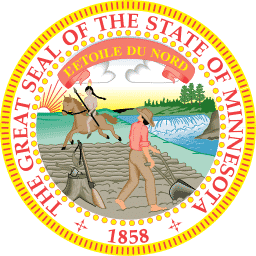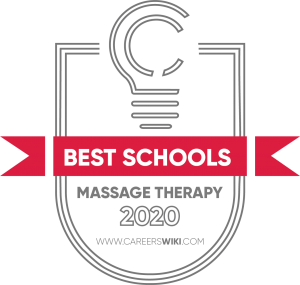…
There are more than a dozen massage therapy schools in Minnesota, from the Twin Cities to smaller communities They include public and privately owned institutions.
All the schools offer certificate, or diploma, programs that require between five months and a year of study. Some have associate degrees that take up to two years to complete. Instruction features classroom lectures, hands-on labs, and clinical practices.
The Gopher State has nearly 4,000 employment opportunities for massage therapists, whose salaries and wages exceed the national average. About 490 additional jobs will be available each year through 2026, according to a government forecast.
You can also find a massage therapy school in another state by visiting our main massage schools page.

Minnesota is one of the few states with no massage therapy board. Practitioners do not need licenses, and there are no rules governing MT school programs or instructors.
Some Minnesota cities and towns impose minimum criteria for curricula. For instance, MT programs in St. Paul must provide 500 clock hours of instruction and training.
Career schools need operating licences from the state Office of Higher Education.
Earning a high school diploma or GED is the first step to become a massage therapist in Minnesota. Taking extra health and science classes in high school helps prepare students for MT training.
Then it is time to find a postsecondary school. An accredited institution that delivers at least 500 clock hours of massage therapy instruction is recommended, to satisfy requirements in many other states. Employers may prefer job applicants from schools with programs meeting the standards of national certification organizations.
Core courses typically include anatomy, physiology, kinesiology, pathology, hygiene, and laws and ethics. Students learn basic Swedish massage and work in clinical settings. The rest of the curriculum is not the same at every school. Some programs cover a wider range of massage techniques than others, provide more clinical experience, or teach students how to establish their own businesses.
Graduates are eligible to look for jobs right away. Unlike almost every other state, there are no examination or licensing requirements. However, prospective practitioners might enhance their employment prospects by taking the Massage & Bodywork Licensing Examination. They can apply for the test online with the National Federation of State Massage Therapy Boards.
Taking continuing education classes every couple of years keeps a massage therapist up to date with professional practices, laws, and regulations.
We selected the schools below based on the programs that they offer, accreditation, student population, graduation rate and reputation.
View our Ranking Methodology to learn more about how we rank schools.

45%
143
A privately owned institution founded in 1950, MSC began awarding massage therapy certificates in 2018 on its campuses in Woodbury and Plymouth.
Students can complete the program in as few as five months of full-time (35 hours per week) day classes. A part-time (17.5 hours per week), evening alternative takes twice as long. The curriculum involves 700 clock hours, including 140 hours of instruction in massage methods.
Classes teach advanced modalities, spa therapies, relaxation and rehabilitation techniques, rehabilitation, and massage business ownership. Students spend 70 hours practicing on real clients at on on-campus clinic.
83%
90
This for-profit institute in Minneapolis offers four MT programs, including an associate in applied science degree.
The 1,350-hour AAS curriculum qualifies graduates for national certification. It takes 20 months full time or 28 months part time to finish. Day and evening schedules are available. Students perform two clinical rotations, one doing massages and the other focusing on Shiatsu.
Diploma programs in Shiatsu and therapeutic massage each consists of 900 hours. There is also a 600-hour massage practitioner certificate. All programs address advanced techniques, Shiatsu, traditional Chinese medicine, massage for special populations, and career development.
43%
936
A private school in Bloomington, NWHSU has multiple MT programs that the renowned Commission on Massage Therapy Accreditation recognizes.
There is a 964-hour certificate in therapeutic massage and a 535.5-hour certificate in relaxation massage. A graduate can obtain an associate in applied science degree by earning 15 general education credits and taking three elective courses. The programs last between 11.5 and 19.5 months. Day and evening class schedules are available.
In addition to the standard subjects, courses teach numerous massage techniques, reflexology, hydrotherapy, craniosacral therapy, Reiki, orthopedic care, nutrition, energy-based medicine, and Chinese medicine and cupping.
78%
412
This school’s owners operate 17 campuses across the country, including a site in Minneapolis. Students receive massage therapy certificates after completing 600 hours of instruction for 18 weeks.
The program is rooted in Ayurvedic techniques. There are courses in reflexology, aromatherapy, the use of flower and plant essences, wellness, business development, and retail knowledge. More than 90 percent of the ingredients that students use are certified organic.
About three-quarters of graduates secure employment in the field. The school provides job-placement assistance with career days and self-promotion instruction.
42%
3263
A public institution in southeastern MInnesota, RCC is an assigned school for Nationally Certified Massage Therapists and Bodyworkers (NCMTB). Students pursue MT certificates on the Austin campus.
The full-time, 12-month program consists of 736 clock hours. There is instruction in stress reduction, deep tissue massage, myofascial therapy, chair massage, reflexology, massage for special populations, aromatherapy, acupressure, ear candling, cupping, spa treatments, and professional communication skills. Students administer massages to the public.
Applicants take a test to determine whether they need classes in English, reading, or mathematics. Incoming students must be certified in CPR.
46%
3298
This public community college has two massage therapy programs on its Willmar campus.
A 30-credit diploma curriculum features classes in Swedish massage, basic Esalen massage, deep tissue therapies, hot stone applications, seated chair massage, reflexology, Shiatsu, myofascial release, energy work, pre/post event sports massage, Gau Sha, ear candling, spa body treatments, business practices, and client communications.
To earn a 60-credit associate in applied science degree, students take the same courses plus electives and general education classes. Those in both programs give treatments to the public at the Student Massage Center. The college boasts a 100 percent job-placement rate.
46%
3362
Another public school, MWCTC has seven locations in southwest Minnesota. Massage therapy students attend classes on the campus in Worthington.
The diploma program, with fall and spring semesters, is composed of 32 credits. The courses are Healthcare & Society, Body Structure & Function, Introduction to Massage, Kinesiology, Basic Massage, Nutrition, Disease Conditions, Massage Therapy, Client Massage, MT Business Practices, and Spa Techniques.
Among the admission requirements are becoming certified in CPR and taking assessment tests.
33%
5281
This community college in Duluth touts the third-lowest tuition rates in the Minnesota state system. There are more than 90 programs, including a diploma in massage therapy.
The curriculum, which takes less than a year to finish, entails 31 credits in more than 600 clock hours. Classes concern stress reduction, Swedish massage, deep tissue therapy, full-body and chair massage, hydrotherapy, neuromuscular therapy, lymphatic drainage, somatic methods, and business plans. Students also learn massage techniques for pregnant women, older adults, babies, and athletes.
A student clinic provides practical experience, and the school offers continuing education classes for practitioners.
29%
6912
A large community college, SPC offers three programs for future practitioners. The curricula are recognized by the Commission on Massage Therapy Accreditation.
The massage therapy certificate program is more than 600 hours. A graduate who stays in school for another 600 hours can earn a second certificate in clinical sports massage. The college also has an associate in applied science degree in clinical sports massage.
Students do patient assessments to create healthcare plans. They become proficient in friction therapy, active and passive engagement methods, trigger point therapy, scraping, fascial release techniques, manual lymphatic drainage, and advanced stretching modalities.
45%
6222
This public school in Fergus Falls awards massage therapy diplomas on its Wadena campus. Some of the courses in the 34-credit program are available online.
The curriculum covers Swedish, deep tissue, chair, sports, and integrative massage; as well as techniques for the face, abdomen, and special populations like the elderly. Other classes teach hydrotherapy, treatment decision-making, nutrition and wellness, professional standards, and ethical business behavior.
Students apply what they have learned during the day at an evening clinic that serves the community on campus.
$23
$48,700
23%
A middle-range practitioner in this state earns about $48,700 a year or $23.40 per hour, better than the U.S. median of around $41,400 or $20.
Those in the top 10 percent receive over $89,100 or about $43, compared with around $78,300 or $37.60 nationwide. The bottom 10 percent make about $23,230 or $11.20 in Minnesota; approximately $21,340 or $10.25 nationally.
The state had 3,610 practitioners in 2016. The U.S. Bureau of Labor Statistics predicted that the figure would escalate to 4,430 within the ensuing decade–23 percent job growth, close to the projected national median of 26 percent.
Sources: U.S. Bureau of Labor Statistics, CareerOneStop

LIMITED TIME DEAL